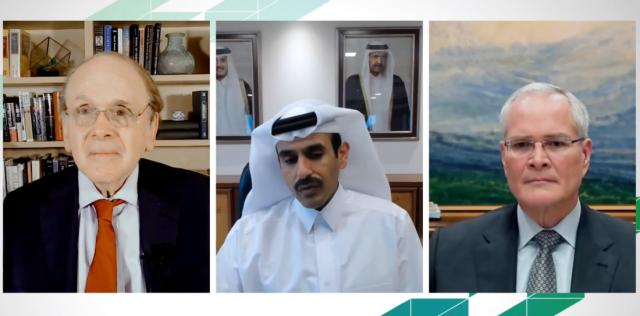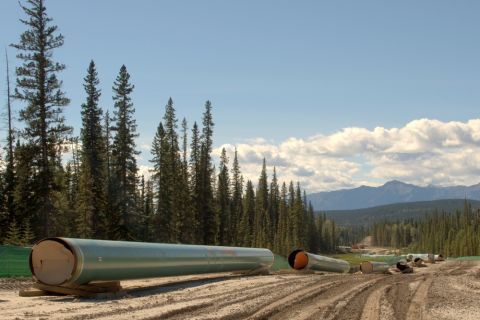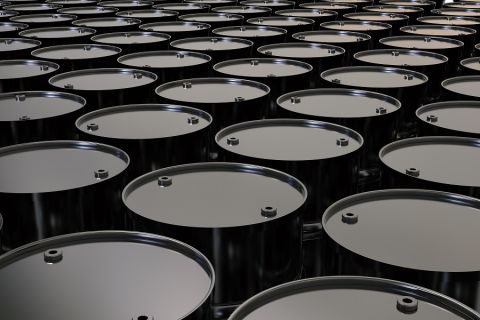
IHS Markit Vice Chairman Daniel Yergin, Qatar Petroleum CEO Saad Sherida Al-Kaabi (center) and Exxon Mobil Corp. CEO Darren Woods (right) speak March 2 about the oil and gas industry’s future. (Source: CERAWeek by IHS Markit)
If there was any doubt about how bullish Qatar Petroleum still is on LNG and natural gas, its $28.75 billion investment in the largest ever LNG project—North Field—should put that to rest.
Speaking during the CERAWeek by IHS Markit virtual conference, Qatar Petroleum CEO Saad Sherida al-Kaabi described the future of the LNG business and gas in general as “rosy.” The company, among the world’s leaders in LNG production, plans to share details on the second phase expansion of the North Field South project by year-end or first-quarter 2022.
“I think it’s going to be in higher demand than we thought just a few years back,” al-Kaabi said of LNG on March 2. With the energy transition, he added, “gas is positioned very well for the future.”
Some oil and gas companies are betting big on LNG as the outlook appears promising despite volatility seen in 2020. As companies work to shrink their carbon footprints, demand is forecast to rise by 3.4% per annum to 2035, creating the need for about 100 million metric tons of additional capacity, according to a recently released report from McKinsey & Co. Though demand growth is expected to slow by growing only 0.5% from 2035 to 2050, more than 200 million metric tons of new capacity will be needed by 2050.
Recent demand spikes seen in Asia bolster al-Kaabi’s confidence.
Qatar Petroleum plans to add another two trains at North Field, which al-Kaabi said will increase the company’s LNG production capacity from 77 million tonnes per annum (mtpa) to 110 when the first phase is complete in 2026 and to 126 mtpa by 2027 as part of the second phase.
The company in February tapped Samsung C&T Corp. to carry out engineering, procurement and construction services and the Chiyoda Technip Joint Venture to construct four LNG megatrains and associated facilities for the North Field East project.
Supporting anticipated LNG growth is an expected rise in gas demand in growing nations, according to al-Kaabi, who spoke on the panel with Darren Woods, CEO of Exxon Mobil Corp.
Woods pointed out the role that gas plays in people’s lives and how it supports economic growth.
“It’s in the industrial applications, which grow with the economy. It’s in power generation, which grows with the economy,” Woods said speaking to the fundamental value proposition of gas for society. “As people’s lifestyles improve and they have access to a better standard of living, their use of electricity grows.”
An added benefit is gas emits less CO2 when combusted compared to coal in power generation.
The biggest growth market for gas and LNG is Asia, according to Woods.
“If you look at where there’s the biggest opportunity for growth, both from an economic standpoint and for people’s lives improving and their standards of living improving, it’s primarily in the non-OECD countries,” Woods said. About “85% of the global population are non-OECD countries, and their energy consumption is about a third of what you see in the OECD countries. So, as that economy grows, as people’s lives get better, you’re going to see increased consumption of energy, and obviously, gas is going to play a key role in that.”
Gas is the only fossil fuel expected to see increased demand beyond 2030, according to McKinsey & Co. The consulting firm forecasts gas demand will rise by 0.9% from 2020 to 2035, peaking in 2037.
The rise comes amid continued focus on emissions and what Exxon Mobil and Woods call the dual challenge, meeting rising energy demand while addressing emissions and risks associated with climate change.
“One of the challenges with gas is the lack of alternatives in all applications in all areas of the world,” Woods said. However, when it comes to having more secure source of energy and supply, gas will play a role. “But with gas comes emissions.”
Exxon Mobil, like many others, have turned to carbon capture and storage to help address emissions.
“We have been doing research for over a decade on carbon capture and storage to try to make that more economic, more effective, to allow us to capture the emissions that are generated by power generation and or industrial applications,” Woods said. “We feel pretty good about the progress we’ve been making in that space.”
RELATED: Exxon Mobil R&D VP Talks ‘Technology Gap’ in Energy
Qatar is also taking aim at emissions reduction targets. Its sustainability strategy aims to
capture and sequester between 7 mtpa and 9 mtpa of CO2 from its LNG facilities by 2027.
“In addition to that, we’re looking at adding some of the additional CO2 delivered…for enhanced oil recovery,” he said, noting oil will be needed and won’t disappear anytime soon. However, “gas is going to be a big part of the solution going forward.”
Recommended Reading
Imperial Expects TMX to Tighten Differentials, Raise Heavy Crude Prices
2024-02-06 - Imperial Oil expects the completion of the Trans Mountain Pipeline expansion to tighten WCS and WTI light and heavy oil differentials and boost its access to more lucrative markets in 2024.
Russia Orders Companies to Cut Oil Output to Meet OPEC+ Target
2024-03-25 - Russia plans to gradually ease the export cuts and focus on only reducing output.
US Oil Stockpiles Surge as Prices Dip, Production Remains Elevated
2024-02-14 - EIA reported crude oil stocks increased by 12.8 MMbbl as February began, far outstripping expectations.
US Leads Global Oil Production for Sixth Straight Year-EIA
2024-03-11 - The Energy Information Administration says it is unlikely that the record will be broken by another country in the near term.
Oil Settles at Highest in Nearly 8 Weeks on Strong Economic Growth
2024-01-26 - Oil prices settled at their highest in nearly two months on Jan. 26 as positive U.S. economic growth and signs of Chinese stimulus boosted demand expectations.



